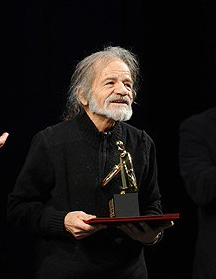Jalal Zolfonun
Jalaal Zulfonun | |
|---|---|
 Jalal Zolfonun at the Fajr International Music Festival (2012) | |
| Background information | |
| Born | March 7, 1938 Abadeh, Iran |
| Died | March 18, 2012 (aged 74) Karaj, Iran |
| Genres | Persian music |
| Occupation(s) | Composer, Setar player |
| Instrument(s) | Setar, Tar |
| Years active | 1968–2012 |
Jalaal Zulfonun (Persian: جلال ذوالفنون, romanized: Jalâl Zolfonun, pronounced [dʒæˈlɒːl zolfʊˈnuːn]; 7 March 1938[1][2] – 18 March 2012) was an Iranian musician, setaar player, and a prominent composer and teacher of Persian music.
Collaboration with Maurice Béjart
[edit]He has also collaborated with Maurice Béjart in the mix of Iranian music and European Ballet dance.
Collaboration with Jean During
[edit]Between 1975 and 1980, he collaborated with Jean During on his acquaintance with Iranian music.
Collaboration with DELA MUNOT (Deauville)
[edit]He also collaborated with the DELA MUNOT Deauville Institute in Brussels to introduce Iranian music to Western European countries.
Concert in the United Nations
[edit]Jalal Zolfonoun performed concerts in 1994 to present Iranian music to the majority of the world at the UN.
Biography
[edit]Jalal Zolfonun was born in Abadeh, Fars, Iran, and received his earliest musical training from his father, Habib Zoufonoun,[3] and his older brother, Mahmoud Zoufonoun on the tar.
At the age of 13, Zolfonun enrolled the National School for Iranian Music to study musical theory, composition and technique under Ruhollah Khaleghi and Musa Khan Maroufi. While he immediately fell in love with setar, the instrument was not taken seriously in those times. He instead decided to study the tar, while also learning the violin from his brother Mahmoud Zoufonoun.
In 1967, Zolfonun was accepted into the faculty of the fine arts department of Tehran University, where he further studied the setar with Master Noor Ali Boroumand and Dariush Safvat.
From then on, he dedicated himself to the delicate instrument. He began combining the techniques of the older masters of setar (an Iranian instrument with four metal strings) with his own ingenuity and mystic sensitivity. For the first time, with Iran's leading classical singer Shahram Nazeri, he founded an ensemble composed of only setar players. Later, in the 1980s, Zolfonoun and Nazeri's compositions were released in two best-seller albums, one of which, Gol-e Sadbarg ("One hundred-petalled Rose"), is the best selling album of classical Iranian music ever.
At the same time, Zolfonun composed for the setar in mind, and would prove one of the most expressive, while technically virtuosic, players of the instrument. He showed the power and versatility of the setar as an ensemble and solo instrument that could fully express the nuances of Persian traditional music in any setting.
Following the success of Gol-e Sadbarg, Zolfonun continued to record a number of other albums on which he is featured as lead soloist, composer and/or ensemble player with a number of well-known singers and musicians with whom he also toured worldwide.
Zolfonun also wrote a seminal book, Setar Playing / Teaching Method.
He lived in Iran, but also toured outside in Europe, the US, Canada and Japan with his son, Soheil Zolfonoon, and other musicians.
Zolfonun died of heart disease on 18 March 2012 in Tehran; he had been hospitalized for two weeks prior to his death for heart failure.[citation needed]
Discography
[edit]- Gol-e Sadbarg ("One Hundred-Petalled Flower") with masters Shahram Nazeri, Reza Ghassemi & Bijan Kamkar
- Atashi Dar Neyestan ("A Fire in the Reed-Bed") with master Shahram Nazeri
- Mastaneh with Alireza Eftekhari
- Parand
- Peyvand
- Kord Bayat (Music of the World)
- Del Aavaa
- Pearl Beads
- Sheydaee
- Mystic Journey (Music of the World)
- 18 Tasnif (Melodic Pieces for Setar)
References
[edit]- ^ "آواهای کمشنیده از دیروز تا امروز • جلال ذوالفنون – DW – ۱۴۰۰/۱۱/۲۱". dw.com (in Persian). Retrieved 2023-08-02.
- ^ "جلال ذوالفنون؛ خالق نواهای ماندگار". www.irna.ir. Retrieved 2023-08-02.
- ^ "Habib Zoufonoun". Archived from the original on 2006-05-04. Retrieved 2006-04-29.
